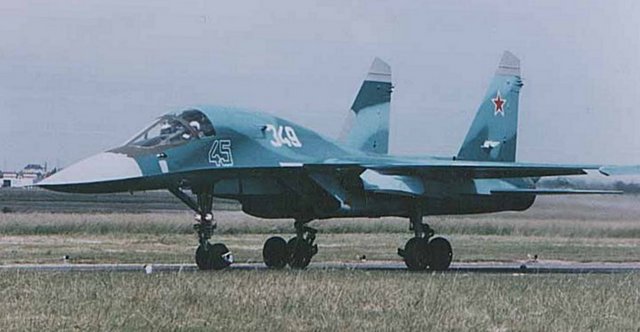
EVIDENCE ACCUMULATES ON RUSSIAN AIR INCURSION INTO GEORGIA
Publication: Eurasia Daily Monitor Volume: 4 Issue: 157
By:

A growing body of evidence confirms that the aircraft that dropped a missile on Georgia on August 6 (see EDM, August 8) entered from Russia’s North Ossetia and returned there, Russian denials notwithstanding. Some confirmation even came from Russian sources at the scene initially, before Moscow moved to suppress such witness accounts.
The aircraft has been identified as a Su-24 fighter-bomber and the missile — which failed to explode — as a Raduga Kh-58, which is designed to hit certain types of structures such as radars. This type of plane and missile are of Soviet-era production and are known to be based at Mozdok in Russia’s North Ossetia. (Georgia has a few Su-25s, but no Su-24 in its inventory.) The missile dropped on a field near Gori, a few kilometers from Georgia’s recently built air-defense radar.
Georgia has made available to foreign representatives in Tbilisi (including Russia’s) the evidence in its possession. Radar data printouts show the intruding aircraft’s path from the direction of North Ossetia, some 80 kilometers southwest into Georgian air space near Gori and back northeast into Russian air space. The material also includes the recorded conversation between Georgian civilian aviation’s flight control monitor in Tbilisi and the Russian counterpart in Rostov-on-Don (responsible for the Caucasus), minutes before the missile drop. The Georgian monitor informs his Russian colleague about a plane intruding into Georgia from Russia and requests clarification. The Russian monitor double-checks with his superiors, then responds evasively that his center has no information about such a flight and generally does not track Russian military flights.
Russian and Ossetian “peacekeeping” troops’ initial reports also testify to Russia’s responsibility. Those troops maintain two permanent posts near the village of Tsitelubani, where the missile fell on August 6. The next day, both of those posts gave their account of the incident to a joint monitoring team of Russian, Ossetian, Georgian, and OSCE military observers. By both accounts, the aircraft flew in from northeast [Russia] toward the southwest, released a missile-like object that fell to the ground, and flew back over the mountains to northeast. These “peacekeepers’” accounts are recorded in two reports: One, co-signed by the Russian, Ossetian, Georgian, and OSCE military observers from the monitoring team, is addressed to the Russian “peacekeeping” troops’ command. The other is a confidential “Spot Report” (August 8) by the OSCE’s Mission to Georgia to the organization’s Vienna headquarters. The organization has acknowledged the report’s authenticity while characterizing it as an internal document that does not necessarily reflect the OSCE’s position.
Also on the day after the incident, the Russian “peacekeeping” commander, Major-General Marat Kulakhmetov, told Russian news agencies (RIA-Novosti, Interfax, August 7, 8) that South Ossetian troops had fired a shoulder-launched Strela missile at the overflying plane, believing it to be Georgian. Authorities in Moscow moved quickly to silence such testimonies. The Strela story is doubly embarrassing because that weapon is banned from the area and the Russian troops have long thwarted the OSCE’s efforts to locate this and other banned weapons in the possession of South Ossetian forces.
Kulakhmetov’s comments and some similar local accounts have led to a supposition that the pilot may have reacted to the unexpected Strela shot by turning tail and jettisoning his own missile, rather than firing it. This is one of the theories that the investigation will be pursuing. Other theories are that the old missile was fired but malfunctioned; or that it fell accidentally. A disturbing common element to these theories is the logical connection between the Russian anti-radar missile and the Georgian radar near which that missile landed. Apart from all these deductions, the fact remains that at least one Russian warplane intruded deeply into Georgia’s airspace while Moscow denies that any Russian flight took place or accuses Georgia of staging the incident.
Russian authorities from Kremlin spokesman Dmitry Peskov to Ministry of Foreign Affairs officials to Air Force Chief of Staff Lt.-General Igor Khvorov all remain in deep denial. The Mozdok base remains silent, as it did on similar occasions in the past. Chief-of-staff of the Armed Forces, General Yuri Baluyevsky, thundered, “This is a provocation against Russian peacekeepers and against Russia as a whole.” Baluyevsky claimed that Georgia is so worried about the possible international recognition of Kosovo’s independence that it is trying to heat up the South Ossetia and Abkhazia conflicts before any such “Kosovo precedent” is set. While this reasoning seems nonsensical, the gist of it reflects Moscow’s growing confidence that it can continually exploit the Kosovo deadlock against the interests of an outmaneuvered West.
Georgia’s Ministry of Foreign Affairs has officially asked Russia’s counterpart ministry for radar data about the Russian SU-24 flight. Moscow had withheld radar data from the United Nations-led investigation of the Russian air raid on the Kodori Gorge (Georgian-controlled Upper Abkhazia) in March 2007. The UN’s investigation was a failure, not least because Russia enjoyed veto power within the investigative team (quite apart from its veto in the UN Security Council). The UN’s evasion apparently encouraged Moscow to relapse into that type of behavior.
While the UN is nominally in charge of the international presence in Abkhazia, the OSCE holds that nominal role in South Ossetia. Any international investigation led by the OSCE could shatter against Russia’s veto in that organization as well. There is no substitute for an independent international investigation — that is, outside the UN or OSCE, independent of Russia’s veto.
(Messenger, Civil Georgia, Interfax, Itar-Tass, August 9-12; see EDM, August 8)




